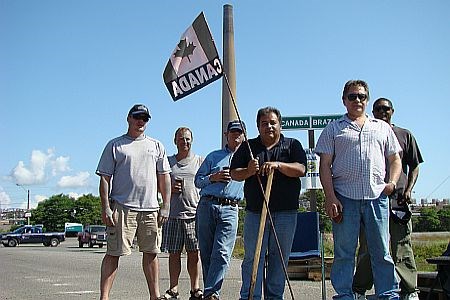Contract issues may separate Vale Inco and striking United Steelworkers at the company's Sudbury and Port Colborne operations, but it's the market that will likely cause the strike to drag on, according to a senior economist with Scotia Capital.
"Unfortunately, I think that this strike is actually likely to be quite a lengthy one," says Patricia Mohr, Scotia Capital's vice-president of industry and commodity research.
"I think the company well knows that the market has been quite weak for nickel in terms of actual shipment volumes, so they may not be in a hurry to settle, so unfortunately, I think it may last for some time."
The strike, which brought nearly 3,500 Vale Inco workers to picket lines on July 13, could find itself affected by the flagging global demand for base metals. Sixty per cent of nickel produced around the world goes into production of stainless steel, which has become very low across the G7 countries, says Mohr.
American stainless steel plants have only been running at 40-55 per cent capacity through the first half of 2009, and similar weakness has been seen in Europe and Japan.
Although nickel prices have been rising through the summer despite the downturn, Mohr says she suspects some of the upward movement has been buoyed by the expectation of strikes at Vale Inco's Canadian operations.
Hedge funds involved in the metal markets have also been driving up prices in expectation of eventual economic growth in North America, something that isn't likely until the end of 2009.
"There has been quite a recovery in the actual price, but the demand levels remain quite weak, particularly in the G7, so it's mainly an anticipation of the improvement that's driving prices up."
Also contributing to improved prices is the renewed strength in China's economy. The country's GDP increased by 7.9 per cent year-over-year in the second quarter of 2009. Its industrial production in the month of June rose 10.7 per cent over the same period in 2008.
What's more, the state has been stockpiling strategic metals such as copper and nickel, creating the perception of tightening supply. This may translate into growing strength for base metal prices, though with inventories are at record highs, this will not occur for several months at least, she says.
This same reduction in inventories may provide eventual advantages for other producers, particularly as the Vale Inco strike pulls 10 per cent of the world's nickel production off the market, says Terry MacGibbon, CEO of Sudbury nickel producer FNX Mining Company Inc.
"In the long run, if there's a significant reduction in the amount of metal for sale, the price should reflect that," says MacGibbon. "That could be a short-term benefit to other nickel producers in that the price may go up, and historically, that has happened."
However, MacGibbon is concerned that current nickel prices are failing to reflect this eventuality, falling "dramatically" by a dollar to $6.50 in the days leading up to the strike before returning to early July levels of more than $7.00.
The strike also affects FNX in more immediate ways, as the company processed its ore at Vale Inco's mill. FNX is now stockpiling ore in anticipation of finding an alternative site for processing in the coming weeks, potentially with Xstrata Nickel.
MacGibbon says he remains confident FNX will still produce 700,000 tonnes of ore through 2009 from its local properties, with plans to spend $15 million in surface exploration through 2010. There are even plans to return some of the 300 laid off workers to the current staff of 400 once the Levack Footwall Deposit is put into production next year.
Regardless, MacGibbon preferred not to see the strike occur at all, with its expected impact on the city and the local industry.
Some of this impact has already been felt among the service and supply industry, which employs 12,000 people in Northern Ontario, including 8,000 in Sudbury.
The faltering global economy has already caused 1,200 direct layoffs and 1,800 work reductions among local suppliers, and a lengthy strike will likely increase that number, according to Dick DeStefano, executive director, Sudbury Area Mining Supply and Service Association (SAMSSA).
While he remains "comfortable" that Northern Ontario's industry base will survive the rigors of the strike, DeStefano also foresees that those who haven't prepared for diversification beyond the Sudbury camp may well fall by the wayside.
This reality has already become evident among some local companies, which have already begun to consider four-day workweeks and other cost-saving measures to preserve their core workers.
"If it's long-term and if the companies SAMSSA represents haven't prepared themselves for other commodity markets in other locations, they're are going to feel a dramatic impact on their business," says DeStefano. "I think the companies who are well-prepared and understood the concept of global marketing, strategic alliances with other commodities are going to make it through this."
www.scotiacapital.com
www.inco.com
www.uswa.ca
www.fnxmining.com
www.samssa.ca




